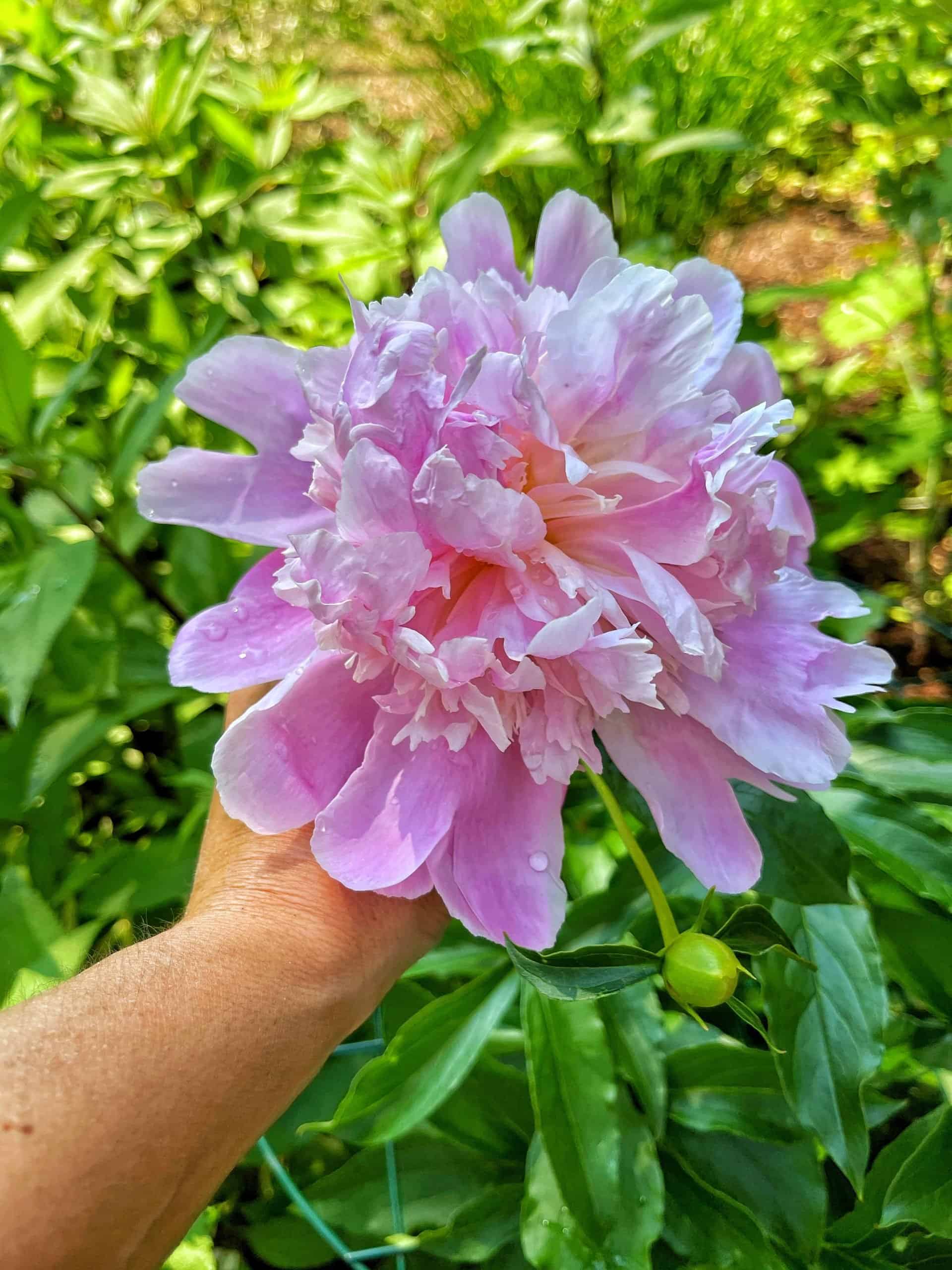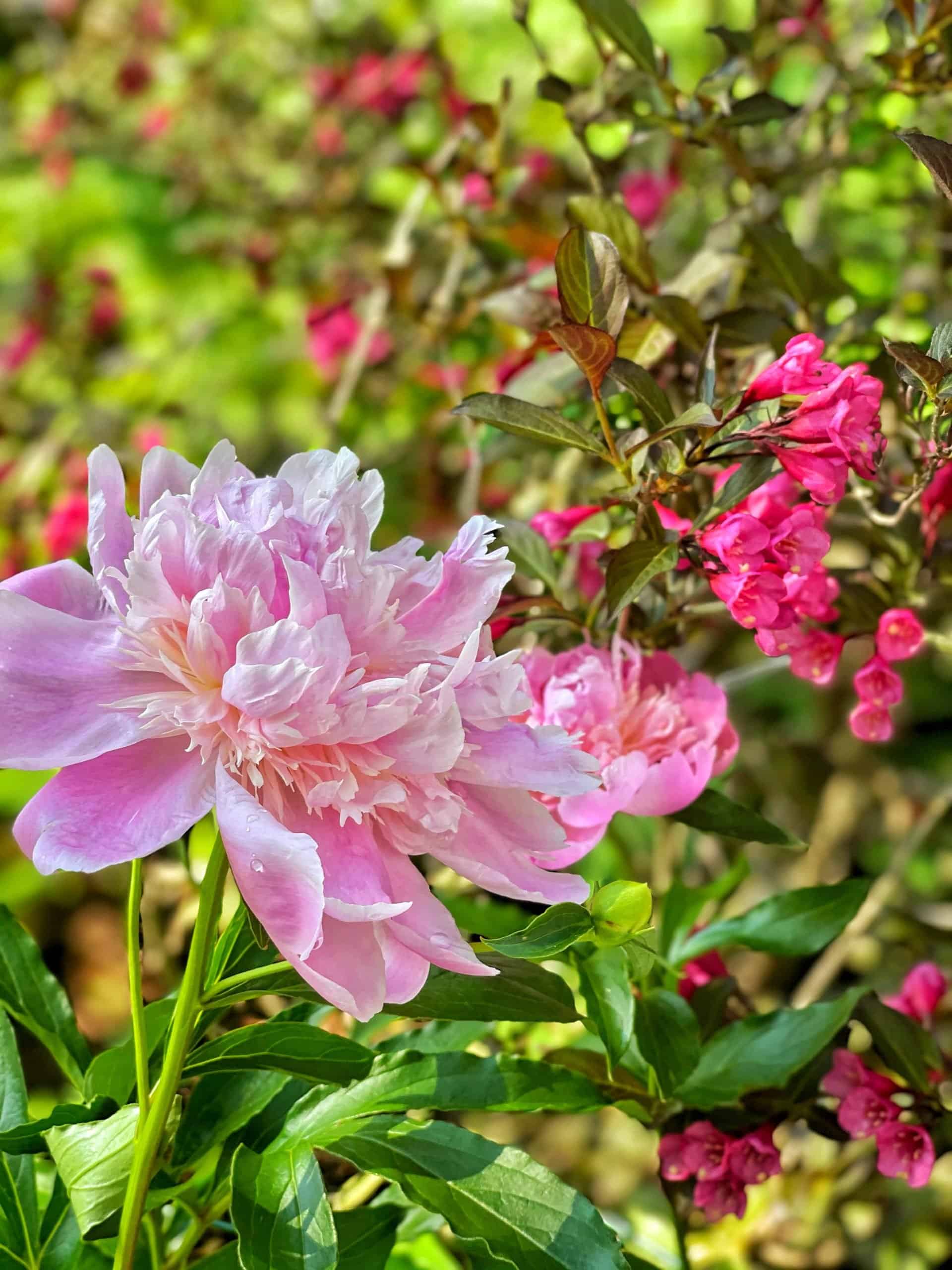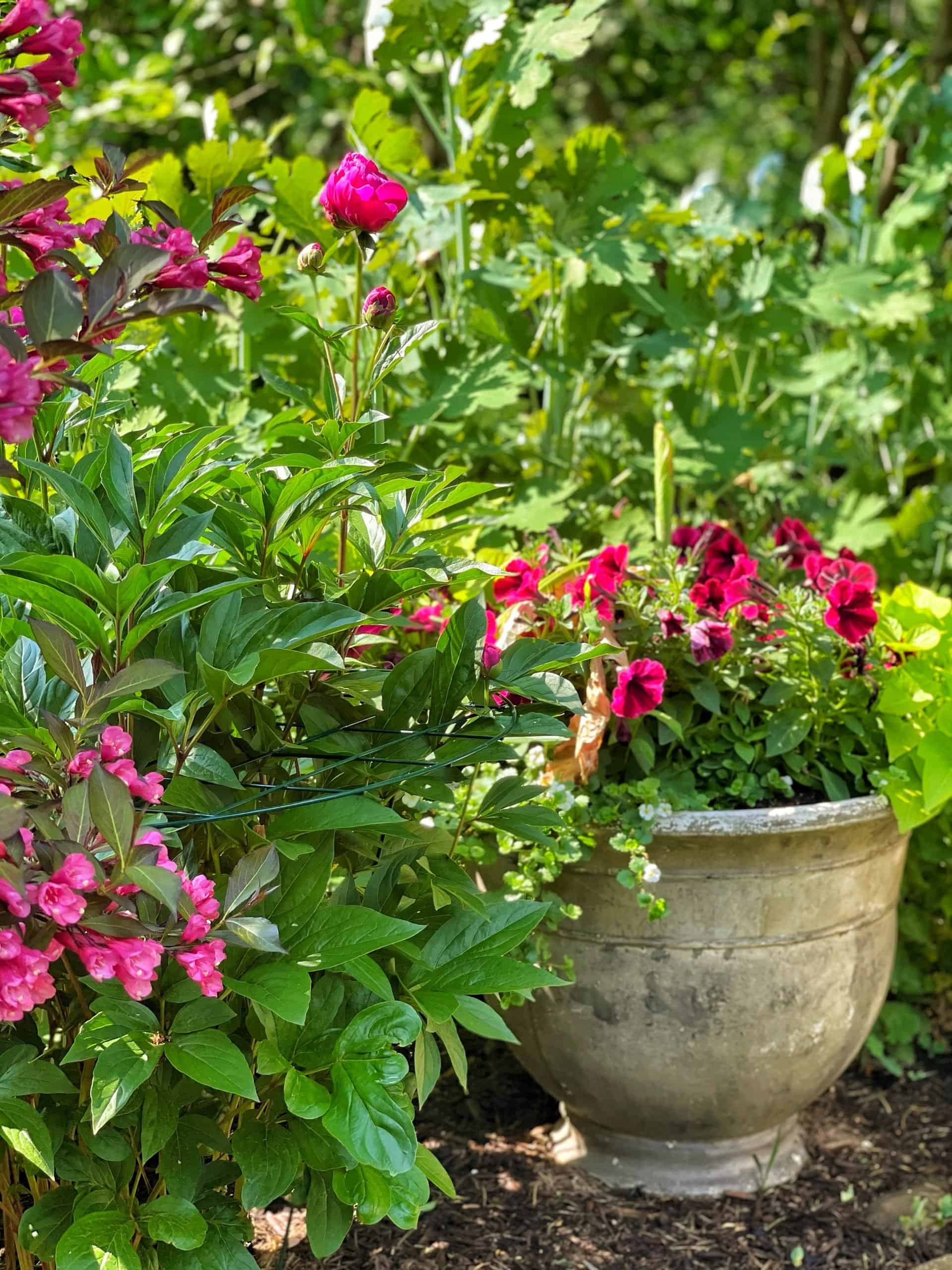Growing peonies made easy! Learn the essentials: sun, soil, and care for vibrant blooms and a thriving garden. Get the longest bloom time in a growing season with these simple tips.
If you are looking to grow an easy-care flower that is deer resistant and simple to care for, look no further than peonies (paeonia lactiflora). Peony flowers are a favorite of many gardeners, and it’s easy to see why. With their large, showy blooms and delightful fragrance, these flowers are sure to add a touch of beauty and elegance to any garden.
But have you noticed the blooms don’t last very long or sometimes they leaf out but don’t bloom at all?
It’s one of the quickest blooms of the season but there are a few tricks you can do to extend their flowering time and promote better blooms. Whether you’re a seasoned gardener or just starting out, this post will provide the information you need to grow and enjoy peony flowers.
From planting tips to maintenance advice, here is everything you need to know.
(Posts on stacyling.com may contain affiliate links. Click HERE for full disclosure.)

Peony Flower Pronunciation
Before we dive into the wonderful world of peonies, let’s talk about proper peony pronunciation because so many people say it differently and there’s actually a right way to say it. So how do you pronounce peony?
It is pronounced as “pee-uh-nee.” Here’s a breakdown of how to pronounce it:
- Start with the first syllable: “pee” – This is pronounced like the word “see” or “tree.” It is a short, unaccented syllable.
- The second syllable: “uh” – This is a very short and unstressed sound, often referred to as a schwa sound. It’s similar to the “uh” sound you might make when you’re unsure or indifferent about something.
- The third syllable: “nee” – This is pronounced like the word “knee” and “tree.” It is also a short, unaccented syllable.
So, when you put it all together, it’s “pee-uh-nee,” with the emphasis on the first syllable “pee.”

About the Peony Plant: A Gardener’s Favorite
Now that we got proper peony pronunciation out of the way, peonies are a popular plant in the flower garden that is known for their beautiful, large blooms and sweet fragrance. They are hardy deciduous perennial flowering plants that can thrive in a variety of climates and soil types, making them a popular choice for gardens and landscapes.
Most peony varieties are native to the Northern hemisphere, throughout much of Europe and Asia. But Brown’s peony (Paeonia brownii) is native to the northwestern United States.
Peony blooms also make excellent cut flowers that bring a beautiful aroma indoors with any bouquet. With proper care, peonies can provide beautiful blooms for many years as they are a classic and beloved addition to any garden or cottage garden.

Top 5 Reasons to Grow Peony Flowers in Your Cottage Garden This Year
If you don’t have them in your garden yet, here are five reasons you should plant them this year.
- Peony flowers have beautiful, fragrant flowers that come in a range of colors including white, pink, red, and yellow.
- Once established, they are relatively low maintenance and do not require a lot of care.
- Paeonia lactiflora can live for many years and even outlive the gardener who planted them.
- They are deer-resistant plants.
- Peony plants can be enjoyed and used in a variety of ways. They are a popular choice for landscapes, can be used in borders, or as a focal point in the garden. The flowers can be cut and used in arrangements.

Exploring Varieties of Peony Blooms
There are several types of peonies to grow and they each have different bloom times from April through June. Regardless of the type you plant, make sure you give peony plants plenty of room because these perennial shrubs can grow differently depending on what you plant and have various growing habits.
Discover the wide array of peony types, each with its distinct charm and growth requirements. This section delves into the four main categories: herbaceous peonies, known for their lush, seasonal foliage; tree peonies, noted for their woody stems and larger flowers; and Itoh peonies, a hybrid combining the best traits of both, and intersectional peonies.
- Tree peonies. They can grow 3 to 7 feet tall, have woody stems and branches, and do not die back in the winter.
- Herbaceous varieties. The most common type can grow 2 to 4 feet tall that dies back to the ground each winter.
- Intersectional can grow 2 to 2.5 feet
- Woodland varieties can grow about 1 to 1.5 feet

Planting Paeonia Lactiflora
Hardy in gardening zones 3-8, plant these perennial plants in full sun or partial shade with well-drained soil that is rich in organic matter. The most important thing to keep in mind is to plant peonies in an area that gets enough sun. Because too much shade can result in poor blooming. So make sure they are planted in a space that receives a good amount of sunlight.
For best results, it is also important to plant peony plants at the correct depth. In general, the crown, or top of the root system, should be planted about 1.5-2 inches below the soil surface. If you plant them too shallow or too deep you may sacrifice the flowering.
And by the way, planting too deeply or shallowly is the most common mistake when growing peonies. Oftentimes, if your peony plant is not flowering, that’s the reason why.

How to Plant Peony Plants
Because how they are planted affects flowering, it’s important to do it the right way. Autumn is the best time to plant them since it coincides with the beginning of the plant’s dormancy. Here are some planting tips you should know.
- Take a soil test and prepare the bed accordingly. Peonies prefer a pH of neutral to slightly alkaline with good fertile soil that has excellent drainage. If the soil is amended well, peonies can be planted in sandy or clay soil.
- When planting purchased or divided herbaceous barefoot peonies, dig a generous hole. Place the peony in the hole and cover the top buds or eyes with only one to two inches of soil. Do not plant the buds upside down. If planted too deeply, flowers will not emerge in the spring.
- It should be noted that bare-root tree peonies should be planted deeper, about 6 inches below the soil surface. Deeply planting helps them grow their own root system.

Fertilizing Paeonia Lactiflora
I don’t fertilize my peonies but instead, focus more on providing good-quality soil with organic materials like compost, well-rotted manure, and leaf mold. To feed them, I add amendments yearly and my plants always look beautiful.
While peonies do not need fertilizer to thrive, some gardeners prefer to use a small amount of a well-balanced fertilizer in early spring before the plant has started to grow to promote healthy growth and abundant blooms.
If you choose this path, look for the kind of fertilizer with a balanced NPK ratio (nitrogen, phosphorus, and potassium) of 10-10-10. Avoid fertilizing the plant after mid-July, as this can stimulate new growth that may not have enough time to harden off before winter.
To fertilize your peonies, you can sprinkle a small amount of fertilizer around the base of the plant, taking care not to get any on the leaves or flowers. ALWAYS follow the label directions of the fertilizer you use. Water the plant well after fertilizing to help the nutrients reach the root system.

Watering Peony Flowers
For healthy peonies, water regularly. But keep in mind they do not like to sit in soggy, wet soil. So it is important to allow the soil to dry out slightly between watering to prevent root rot. And make sure there is good drainage where planted.
Always water the base of plants in the earlier part of the day so the water has time to evaporate before nightfall. This will help prevent pest and disease problems with your peonies. That said, if your peonies need water and you can only do it later in the day, water your plants!

Essential Techniques for Supporting Peony Flowers
Most plants have a spreading, vertical, or compact form. Some tall herbaceous varieties with large, heavy blooms and long stems require additional support to remain upright. Whenever I stake my peony plants, I use these grow through garden supports because they work really well and keep the blooms upright. And these are really good to use not only on peonies, but other flowering plants that need additional support too. So stock up on them in early spring.
A word of advice though. Set plant supports out as the plant emerges from the ground, because before you know it, it will be too large to support it with ease. I realize it won’t look great for a bit, but trust me spring growth happens fast if you aren’t paying attention.
Some herbaceous peonies have smaller, fewer flowers, with short, sturdy stems that may require less support. So it really depends on the variety of what you are growing. The plant tag that comes with your peony should tell you whether it requires additional support or not.
Tree peonies with healthy, mature stems do not usually need staking.

4 Ways to Support Peony Flowers
Peony flowers can be heavy and may fall over due to their weight, especially during heavy rainfall or windy conditions. Here are some ways to support peony flowers and prevent them from falling over:
- Staking: You can use bamboo stakes, metal stakes, or even old wire hangers to stake your peonies. Place the stake near the base of the plant and gently tie the stem to the stake using soft twine or garden tape. Make sure to tie the stem loosely so that it has room to grow.
- Caging: You can purchase a pre-made peony cage or make your own using wire fencing. Place the cage around the plant and gently guide the stems through the openings in the cage.
- Ring support is a circular-shaped support made of metal or plastic with legs that are pushed into the ground. You can place the ring support around the peony plant, and it will provide support for the stems as they grow.
- Use companion plants in your garden design. Planting companion plants such as tall annuals or perennials, like delphiniums or salvia, near the peonies can provide additional support. The companion plants can act as natural stakes for the peony stems. To me, this is the least effective method.
It is essential to support your peony flowers as soon as they start to grow, so they don’t become weak or fall over. For more information about the best ways to support peonies to keep them upright and off the ground, read my post here.

Managing Pests and Diseases in Peony Plants
While peonies are pretty easy care for, they are prone to a few pests and diseases. If you see ants on the flower heads before blooming, do not worry and leave them be. They help open the flowers.
Peony wilt is the most common reason you’ll see stems rotting. To keep this from occurring, avoid Iplanting peonies too closely together. When you see this botrytis blight, remove any leaves with dark spots on them to reduce fungal spread. And when cutting back the foliage in fall, pick up all the leaves, remove, and do not compost them.
Walk your gardens every day to regularly inspect peony plants to help prevent major problems.
Peony Propagation
Propagate herbaceous peonies by division in the fall. To divide them, cut the faded foliage back. Then dig and lift the plant out with a garden fork removing as much of the soil as you can. With a hori hori knife, cut off sections of the crown making sure each has at least three buds with roots. Then replant immediately.
Tree peonies are not fans of division so leave them be. These are best propagated by seed or layering a stem.

Tips for Long-Lasting Flowers
One of the biggest drawbacks of growing peonies is their short bloom time. But you can easily plant and blend successive blooms with different flower forms so that peony flowers last for 7-8 weeks from April through June.
Thus, planting different types of peonies will extend your bloom time. If you want a continuous set of peony blooms, here is the order in which they flower through a growing season.
- Woodland peonies
- Tree peonies
- Herbaceous Varieties
- Intersectional hybrids, like Itoh
When planting, keep in mind their light requirements too to get the most blooms out of your peonies too. In general, most peony flowers prefer full sun, particularly herbaceous species and intersectional varieties like Itoh.
Tree peonies can tolerate full sun to dappled shade, however, they will do much better when planted in full sun. And the woodland peony prefers spring sun and summer shade.

Growing Peonies FAQs: Expert Answers to Your Common Questions
What Do Peonies Smell Like?
Peonies have a range of fragrances from spicy and citrusy to rosy and sweet. Some paeonia lactiflora are more strongly scented than others. Plant peony plants near outdoor seating areas such as decks, patios, porches, and firepits to get a whiff of their incredible scent while enjoying your gardens.
What Season Do Peonies Bloom?
Depending on the type of paeonia lactiflora you grow, they range in bloom time from April through June.

Do Peonies Like to Be Moved?
While peonies can tolerate being moved, it is best to avoid relocating them where possible. So think through the planting location beforehand. They have deep root systems that can take several years to become fully established when relocated. Thus, they may take longer to bloom and may not perform as well as they would have in their original location.
If you do have to move a peony, the best way to do it is in the fall or early spring when the plant is dormant. And make sure to get as much of the root ball as possible when carefully digging it up. Be sure to replant in a location with well-draining soil and full sun or partial shade. Water the plant well and add a layer of mulch around the base to help retain moisture and keep weeds at bay.
Because peonies do not love being relocated, it is important to remember that they may take a while to bloom, even years, after moving. So be patient and give the plant time to re-establish itself in its new location before expecting it to produce flowers.

Why Didn’t My Flowers Bloom?
There are several reasons why peonies may not bloom. Some common causes include:
- Planting depth. Peonies should be planted with the crown (top of the root system) about 1.5-2 inches below the soil surface. If the plant is planted too deeply, it may not have enough energy to produce flowers.
- Lack of sunlight. Peonies need at least six hours of sunlight per day to bloom properly. If the plant is growing in an area with too much shade, it may not bloom.
- Poor soil quality. Peonies prefer well-draining, fertile soil that is rich in organic matter. If the soil is poorly draining or lacks nutrients, the plant may not bloom.
- Overfertilization. Peonies do not need fertilizer to thrive. In fact, too much fertilizer can actually prevent the plant from blooming. Focus on improving soil quality instead.
- Pests or diseases. Peonies may not bloom if they are infested with pests such as aphids or if infected with a fungal disease. Make sure the plant has ample room around it for good air circulation to help prevent pest and disease problems.
If you are having trouble getting your peonies to bloom, try examining the plant for these common causes and taking corrective action.

Final Thoughts About Growing These Gorgeous Cottage Garden Flowers
Ready to transform your garden with the timeless beauty of peonies? Start your journey today by following our comprehensive guides and expert advice. Don’t forget to sign up for our newsletter to receive the latest gardening tips and exclusive updates.
Whether you’re a seasoned gardener or just starting out, we’re here to help you grow peonies like a pro. Join my community and let’s bring more color and fragrance to your outdoor space!
Do you have a favorite peony variety you enjoy growing? What are our tips for growing peonies? Let’s chat more about growing peonies in the comments below.
For more information about growing peony flowers, please see this article from Penn State Cooperative Extension.
To drill down on more beginner gardening techniques and tips, please read these posts:
- Flower Gardening 101
- Growing a Cut Flower Garden for Beginners
- Container Garden Ideas for Beginners
- How to Start a Vegetable Garden
- Herb Gardening for Beginners
Happy Gardening!










